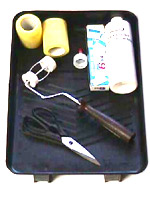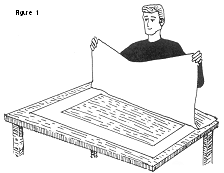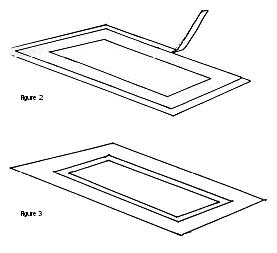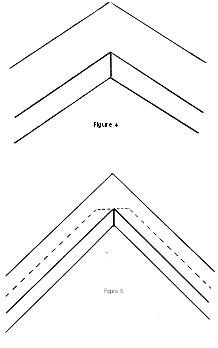WRAPPING MATS – Materials needed: Fabric, mat, FABRIMOUNT, foam-type paint roller, sharp razor blades, cutting surface (scrap matboard works best), and a piece of cardboard or heavy paper larger than the mat.
 Begin by cutting the mat in the normal manner. A regular bevel works best. If a fillet is to be used, a reverse bevel is recommended. Please note that all fabrics,including Framing Fabrics fabrics, are guaranteed to have imperfections. For this reason we recommend that you place the mat under the fabric to select the section of fabric you want to use. At this point, it is important to make sure the grain of the fabric is straight. This done, trim the fabric to about one inch from the outside edge of the mat and set the fabric aside. Place the mat on cardboard or heavy paper and you are ready to start using the FABRIMOUNT.
Begin by cutting the mat in the normal manner. A regular bevel works best. If a fillet is to be used, a reverse bevel is recommended. Please note that all fabrics,including Framing Fabrics fabrics, are guaranteed to have imperfections. For this reason we recommend that you place the mat under the fabric to select the section of fabric you want to use. At this point, it is important to make sure the grain of the fabric is straight. This done, trim the fabric to about one inch from the outside edge of the mat and set the fabric aside. Place the mat on cardboard or heavy paper and you are ready to start using the FABRIMOUNT.
Pour an adequate amount of FABRIMOUNT into a paint tray. FABRIMOUNT is similar in viscosity to pancake batter, so it is possible to simply pour it onto a piece of scrap matboard if you don’t have a clean paint tray available. Pour enough adhesive to complete your project without having to stop and pour more. Remember,time is critical because this is an air-dry adhesive. The formulation is perfect as is, so please DO NOT DILUTE! (Diluting will reduce the adhesive quality and increase the potential for warpage.)
“Load” the roller with adhesive, removing any excess as you would if you were painting. Apply a uniform coat to the mat, making sure to include the bevel and the corners. Take the time to remove any runs or concentrations of adhesive that might bleed through the fabric. This is easy to do if you are using the right tool: a foam-type paint roller. As soon as you have a uniform coat, remove the mat from the cardboard or paper and place it on a clean cutting surface. You now have about two minutes to accomplish the following.
Immediately place the fabric on the mat (See Figure 1). It will not adhere until you apply pressure. This is the time to orient the fabric; make sure the grain is



straight, and so on. Once you are satisfied that this is so, begin to apply pressure with the tips of the fingers. The sooner you start to apply pressure (the fresher the adhesive is), the better it will penetrate the fibers of the fabric. And this is what determines the effectiveness of the bond. Start by locating the bevel and the corners, then massage the face of the mat, gradually increasing pressure as the seconds tick by. Continue to do so for two or two-and-a-half minutes to ensure a firm bond. To remove the excess fabric, turn the mat face down on your cutting surface. Using a sharp razor blade, and using the outside edge of the mat as a guide, cut away the excess fabric (See Figure 2). Next, cut the window out of the fabric, leaving about one inch of fabric to wrap around the window of the mat (Figure 3).
The next step is to cut the fabric diagonally at each corner (Figure 4), taking the precaution not to cut beyond the
bevel of the mat. If you cut too far, the bevel of the mat will be exposed when you wrap the window. This is a common mistake among beginners, and it is a mistake that can be very easily avoided by taking the above precaution.
Finally, using the roller, apply a one-inch band of adhesive around the back of the window of the mat (Figure 5). Begin the wrapping process by starting in the middle of each side and working your way toward the corners (Figure 6). Wrap one or two inches at a time, making sure the fabric is wrapped smoothly all along the bevel. When wrapping, it is never necessary to force, stretch, or pull the fabric. Simply place the fabric where you want it and press it down with your hands, gently at first, gradually increasing the pressure as the adhesive dries.
Finish by carefully paying extra attention to the corners. It is a good idea to add a little adhesive to the back of each corner to guarantee a good bond and to eliminate the possibility of fraying.
From the time you pour the FABRIMOUNT, you can expect to spend approximately eight to ten minutes wrapping and trimming a mat.
TROUBLE-SHOOTING – FABRIMOUNT is a very user-friendly adhesive, so it’s difficult to use it wrong. If, however, you should experience “bleed-through”, the chances are that you will be able to save the project if you simply leave it alone and let it dry. Most of the time, you will not be able to see it because it dries clear. If you can see it, you will probably be able to peel it off. Trying to clean it while it is fresh will only result in grinding it into the fabric, making it impossible to remove.
Another potential problem is “air bubbles”, or a loosening of the fabric. This condition usually results when there is no adhesion. The lack of adhesion is caused by a) an insufficient amount of adhesive, b) the adhesive dried before any pressure was applied, or c) you didn’t use FABRIMOUNT.
© Neuberg & Neuberg Importers Group, Inc. All rights are reserved.


